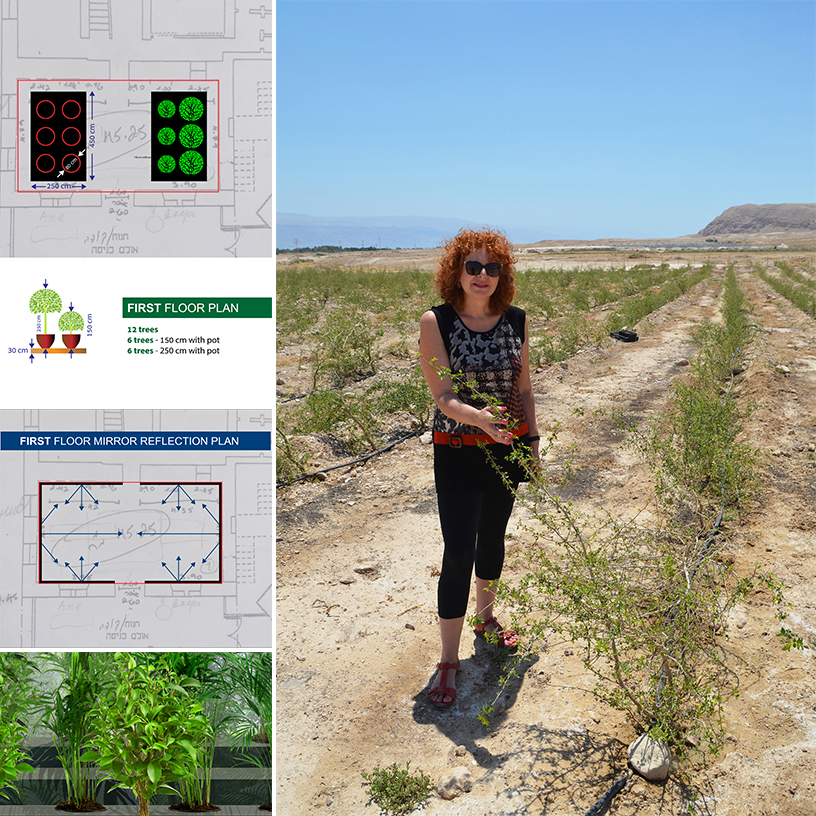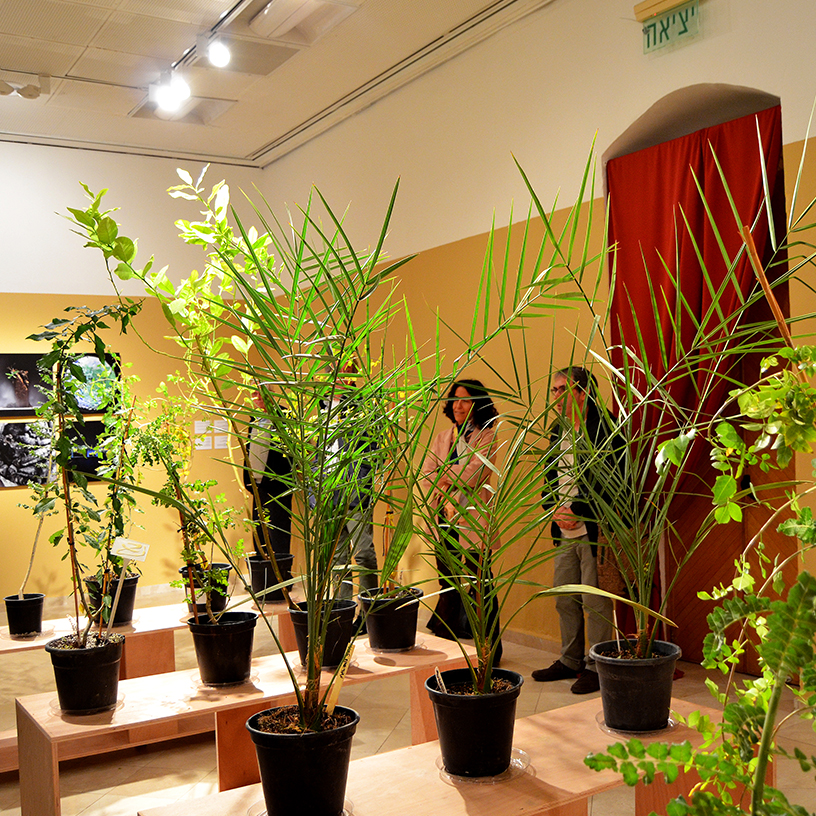ANCIENT FUTURE FOREST
in collaboration with Olga Kisseleva
Installation

The “Ancient Future Forest” installation is the brainchild of Olga Kisseleva and Lilia Chak. It consists of three afarsimon trees, three frankincense trees, three citron trees, and three date palms. The citron tree and the date palm bear fruit, while the afarsimon and the frankincense have a powerful olfactory impact, despite not bearing edible fruit. All in all, there are four “triads” of trees, grouped by species. The three afarsimon trees are combined with the three palms, together making up the composition to the right of the entrance to the room. The citron and frankincense trees are also grouped together, making up the composition to the left of the entrance. Behind each group of trees, there are mirrors that multiply them, creating the illusion of a forest space.
The structure of the “Ancient Future Forest” installation is a continuation of the compositional solutions implemented by Olga Kisseleva in the “Le bonsaï du Taxus” project. Both of these projects develop the ideas underlying two key works of Bio-art: E. Steichen’s “Steichen Delphiniums” and G. Gessert’s “Iris Project”.
The artists have created the image of an exotic forest with minimal artistry. The plants making up the installation are an image of the Garden of Eden. Emphasis is placed exclusively on the trees themselves, which thereby become “living sculptures” of sorts.
This artistic approach – which uses modest, yet expressive, means – enables us to grasp the key idea of the project. As in the case of “Steichen Delphiniums” and “Iris Project”, the installation lets us approach the plants directly, touch and smell them, enjoying the powerful olfactory impact of the afarsimon, frankincense, and citron trees. This creates a powerful immersion effect, akin to the effect of “presence” achieved in Ilya Kabakov’s installations, where the artwork draws the viewers into its space and holds their attention “captive.” In Olga Kisseleva and Lilia Chak’s installation, this effect is magnified thanks to the mirrors placed behind each group of trees. At the “Listening to Trees across the Jordan River” exhibition, we encounter mirrors for the first time in the interactive panels of the “Biological NetWork” installation. The motif of reflection is then developed further in the “Ancient Future Forest” installation.
The installation space has been constructed, according to the tradition of immersive art, as an immersive theater space, which has no auditorium (in the conventional sense) and no “fourth wall” separating the actors from the audience. In such a theater, the action can unfold in several directions simultaneously. The authors of “Ancient Future Forest”, like immersive theater directors, present the public with new behavioral scripts, letting them become active partners in the project.
Visitors to the exhibition are encouraged to choose their own trajectory of movement among the various clumps of trees. In this way, they are essentially asked to assemble their own storyline out of the disparate “puzzle” pieces that have been supplied to them by the artists. We know that information about the irritants that affect the receptors of the human sense organs is transmitted to the central nervous system. It analyzes the incoming data, identifies it, and creates the human sensations. A response is then generated and transmitted via the nerves to the relevant body parts.
The “Ancient Future Forest” installation simultaneously affects all of the viewers’ senses. It “feeds” their sight, hearing (by immersing them in the rustling of the leaves), smell, and touch (by enabling them to touch the trees and experience various tactile sensations). The structure of the installation sustains the illusion of a forest in an urban space. It embodies the currently popular architectural trend of the exterior seeping into the interior. The trees, being placed in the museum space, fill it with the special atmosphere of an ecological “holiday”, which is intended for both adults and children. “Ancient Future Forest” reflects the new ecological idea of getting “closer” to nature without leaving the urban environment. The installation enables the viewers to feel themselves at one with nature, perceive the harmony of the surrounding world, and take a break from the hubbub of city life. The space created by the artists is a successful example of building an ecological dendro-future.
Shows:
- – Listening to Trees across the Jordan River. Prof. Olga Kisseleva`s solo exhibition. Lilia Chak participated in the exhibition in her video installations and photographs in frame of her PhD research in Sorbonne. Negev Museum of Art, Beer-Sheva, Israel. Curator: Dr. Dalia Manor.
Media:
- – Olga Kisseleva, Lilia Chak,
Adopters of Creative Technologies
, article , The Encyclopedia of New Media Art: Volume 2: Artists & Practice, Bloomsbury, London. - – Lilia Chak,
Contemporary Practices in Bio-art: When a Tree Becomes an Artwork
, book published by Cambridge Scholars Publishing (ISBN: 1-5275-1949-X; ISBN13: 978-1-5275-1949-7; Pages: 562; Color illustration: 174). - – Prof. Ilia Rodov,
Concluding Remarks: Contemplations in the Desert on Nature, Creation, and Art
, article. Art and Biology: The Meeting Point. International symposium. Negev Museum of Art, Beer-Sheva, Israel. - – Lilia Chak,
Between Art and Science
, brochure (hebrew) for "Listening To Trees Across The Jordan River" exhibition. Negev Museum of Art, Beer-Sheva, Israel.


